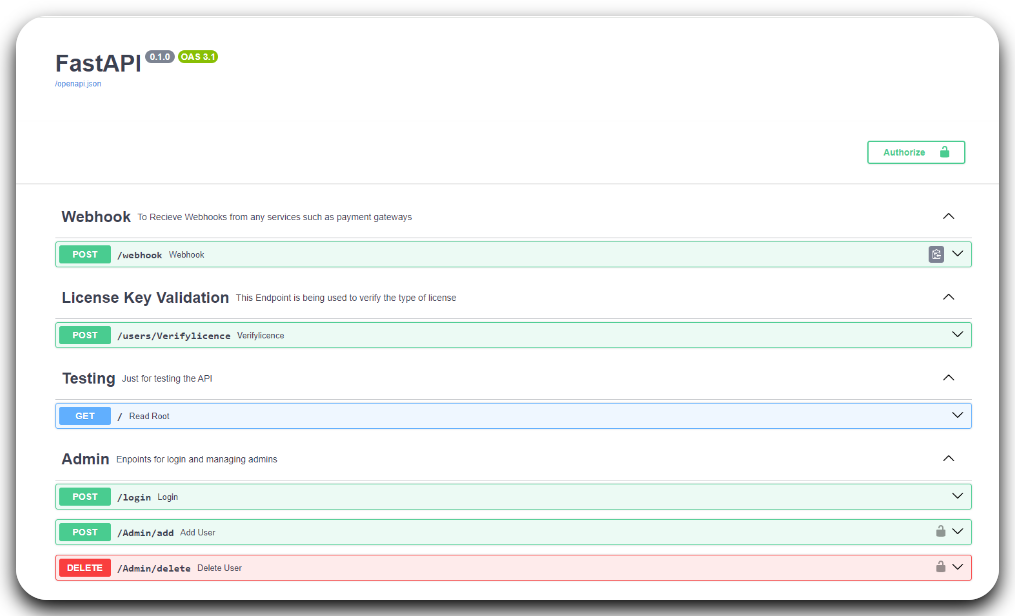- FastAPI - Python framework for building APIs.
- 🙋 Whenever a new user is created the license details are generated and saved to database.
- ➿ Fields to save product type, Licence validity, etc.
- 💸 Generate users from webhooks using payment gateways.
- Pydantic - Used by FastAPI, for data validation and settings management
- PostgreSQL as the SQL database.
- 💾 Two tables, one for user data and one for admin data.
- 📃 Supports pagination and filters to easily create admin dashboards.
- SQLAlchemy - SQL toolkit and Object-Relational Mapping (ORM) library.
- 📄 Complete helper functions for CRUD operations on user and admin tables.
- 🔐 All the passwords are secured using bcrypt hashing.
- Alembic - Database migrations tool for SQLAlchemy.
- ⚡Script to initialize the database from models and make changes as needed.
- OAuth2 - Authentication framework used for user authentication.
- 🔒 Oauth2 Scopes for permissions for specific endpoints.
- JWT - JSON Web Tokens for secure communication.
- 🔑 Configurable JWT tokens from .env files
- Pytest - Unit and Integration testing using Pytest.
- ✅ Tests are broadly divided into database tests and endpoint tests with reusable fixtures
I developed a SaaS backend to create and manage the end users. It involved generating and verifying license keys for new software purchases, API endpoints for creating/deleting and modifying existing users, etc. All the endpoints are authenticated using JWT and OAuth2 with scopes to limit the access of endpoints.
I thought of making the entire template into a boilerplate code so that other people could save time when developing something similar.
-
Clone the repository:
git clone https://github.com/shekhuverma/FastAPI-SaaS-Template.git cd FastAPI-SaaS-Template -
Create a virtual environment and activate it
python -m venv venv
Activate it using
#on windows venv\Scripts\Activate #on linux source venv/Scripts/Activate
-
Install dependencies:
pip install -r requirements.txt
-
Configure the environment variables in the template.env file and rename it to .env
-
Run alembic migrations to create the tables.
alembic upgrade head
This will initialize the database and create the tables as per models.py
-
Add initial data to the database
python -m src._init_db
This will add the first admin to the admin database.
-
Run the application:
cd src uvicorn main:app --reloador
cd src fastapi dev -
Visit
http://localhost:8000/docsin your browser to access the API docs.
All the tests are done using Pytest.
To run all the tests, run the following command
pytest testsor you can use tox for testing and linting
tox
This will run all the tests, formats and lints the code using Ruff.
Tests are divided into 3 major types
- Database tests - Contains the tests for database services and operations
- User tests - Contains tests for all the user endpoints
- Admin tests - Contains tests for authentication and admin endpoints.
If you change anything in the models.py file, then delete all the files from the alembic/versions directory and run the following command to generate the new migration.
alembic revisions --autogenerate -m "your message"This will create a new migration with your changes in the models.
| .pylintrc # Pylint configuration
| alembic.ini # Alembic Config
| LICENSE # License File
| README.md # Project Readme
| requirements.txt # Dependencies
|
+---alembic # Alembic config folder
| ├── env.py
| ├── README
| ├── script.py.mako
| └── versions
| └── 2024_05_17_initialising_database.py # Migration to initialise the DB
+---src # Source code folder
| ├── init_db.py # To initialise the database using superuser (First admin)
| ├── main.py # Main.py, the app starts from here
| ├── settings.py # Config and settings for the project
| ├── db # Database related files
| │ ├── database.py
| │ ├── model.py
| │ └── services.py
| ├── docs # FastAPI Documentation metadata
| │ ├── docs.py
| ├── router # API routes files
| │ ├── admin.py
| │ ├── user.py
| ├── schemas # Pydantic models for request/response schemas
| │ ├── admins.py
| │ ├── token.py
| │ ├── users.py
| ├── security # Security related files
| │ ├── jwt.py # JWT generation code
| │ ├── license.py # Code/settings for generating license keys for users
| │ ├── security.py # Authentication and OAuth2
| │ └── utils.py # Misc helper functions
| └── utils # Utility functions
| | └── csv_utils.py # Utilities for uploading data using CSV files
| |
+---tests # Test files
| ├── admin_test.py # Admin Tests, Login Tests
| ├── conftest.py # Test Fixtures
| ├── database_test.py # Database services unit tests
| └── user_test.py # API tests
All the general configurations are in the setting.py file and .env file. Most of which are self-explanatory. Used Pydantic-settings for dividing the configuration settings.
Currently have 2 shemas, one for the database and the other for the users. src/db/models.py
users ->
txid # Saves the transaction ID
amount # Pucharse Amount
payment_method # Payment Method used for the purchase
product # Name of the product/ Product Type (ENUM src/schemas/users)
email_id # Email of the user
contact_no # Contact number of the user
subscription # Licence validity (in months)
order_date # Purchase Date
Start_Date # License Activation Date
End_Date # License Expiry Date
License_Key # Unique License Key
License_Activated # Whether the License key has been used or not
admins ->
username # Admin Username (Must be unique,PK)
disabled # to disable the admin
scope # Scope of permissions (ENUM src/schemas/admins)
hashed_password # Password stored as hash
License keys are generated using Transaction_ID + Email_ID -> encrypting using AES. The implementation is in src/security/license.py. It is added as a dependency in create user endpoints. You need to change the encryption keys SECRET_KEY and INITIALISATION_VECTOR from settings.py file.
- Add Tox Support for automatic testing and linting.
- Add test cases for different OAuth Scopes.
- Add Docker Support.
- Add Deployment Scripts.
- Email or OTP-Based Password Recovery.
- Use poetry for dependency management. (maybe)
This project is licensed under the MIT License.
